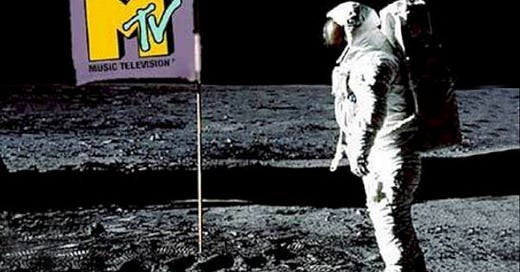The high concept:
It’s an entire television channel (albeit a cable channel with limited reach when it launched) of music videos and fun stuff fronted by young(ish) and groovy types. It’s exciting, radical, the future and what do you know, for once the hypemeisters were right.
For it was indeed the future for a while and slightly unfortunately for some.
The show:
Initially, the American incarnation featured a revolving menu of music videos, interspersed with chat, wisecracks, animated station idents’ and a little bit of good-natured joshing and gossip masquerading as news.
This fast-paced and (let’s be honest) repetitive formula quickly began to drag and was soon replaced with a more genre-specific format (Yo! MTV Raps, 120 Minutes, Club MTV), which then, when audiences began to drift as MTV clones arrived in the multi-channel universe, morphed into more mainstream (including reality) programming.
Copied in terms of format with local twists by its international partner, MTV today is the slightly stodgy BBC1 to the diverse MTV multi-channel universe (MTV2, MTV Classic, MTVU etc.) and the brand itself remains as it has always been; less hip than it thinks it is and, despite the critics and the apathy of the shoulder-shrugging kids, just as influential with corporate advertisers the world over.
So what happened?
Originally the idea of corporate wunderkids Bob Pittman, Jack Lack and ex-Monkee Michael Nesmith, MTV launched on 1 August 1981, backed by American Express and with a subscriber base of half a million (possibly slightly bemused) television viewers.
Not so groovy now, is it?
Initially available only in limited areas it struggled at first, until championed by the youth of America (in those limited distribution areas) and thrown into the headlines with clever, of-the-moment and riveting advertising campaigns (I Want My MTV probably being the best-known).
Increased distribution and commercial success followed as record companies and advertisers fell over themselves to see the opportunity staring them in the face and MTV as a brand went global.
MTV Europe was a bit of a wobble (probably because in the early 90s nobody really knew what Europe was — reflected in the first listless, MTV Europe incarnation) and its assault by an army of MTV-alikes left the original brand looking a little (oh no!) old.
Hot or miss?
In terms of a television culture that has overwhelmed the globe since the 1950s, MTV is probably one of the most influential channels and brands on the planet.
Partly because of the combination of personalities (no wilting wallflowers Pittman or Lack) and time and place, MTV has become cemented in Western liberal popular culture. It defined the 80s and 90s; through Rock The Vote motivated young Americans to vote, which in turn helped Bill Clinton get elected in 1992; exported its distinct brand of creative, liberal Americana around the world and helped join in the minds of the (at times open-mouthed) audience the vital link between new technology and consumerism.
And that’s before all the Michael Jackson and Madonna stuff.
A genuine hit no matter how you measure it.
Remembered mainly today for what?
As being “pornography for children” (Dawn Edwards), for Thriller, Turn Off The Tap, The Osbournes, the MTV Music Awards, Break The Addiction, MTV News (the worst television news programme of all time), Madonna burping (and farting), I Want My MTV, the MTV spaceman (actually Neil Armstrong with a little neon scribble, as above); for launching (and owning) uber-schmoozer channel VH1; for Think MTV, The Real World (the best reality series ever), Vote Or Die, Making The Band, Celebrity Deathmatch, Video Killed the Radio Star (the very first video aired on the channel), Beavis and Butt-head, Jackass, MTV Unplugged and for changing the world.
Forever.
MTV
National Amusements & Paramount Global, 1981–





